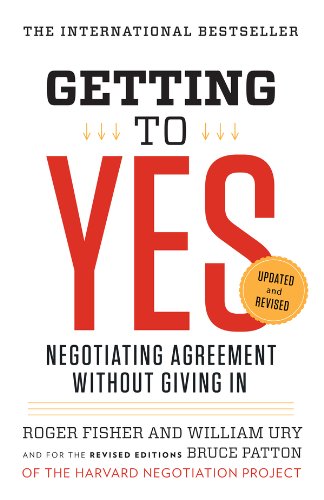

This article is an excerpt from the Shortform summary of "Getting to Yes" by Roger Fisher and William Ury. Shortform has the world's best summaries of books you should be reading.
Like this article? Sign up for a free trial here .
What is a Best Alternative to a Negotiated Agreement? And why do you need to have one when you’re negotiating?
A Best Alternative to a Negotiated Agreement, or BATNA, is the most advantageous option you have if negotiation fails and you can’t reach a deal.
Learn why you should always have a Best Alternative to a Negotiated Agreement, and how to create one.
When to Use the Best Alternative to a Negotiated Agreement
Sometimes there’s a significant power imbalance between your side and the other side in a negotiation. They may be richer, have more physical and human resources, have connections with people in power, or have power (social, political, or economic) themselves. But even though it seems like they have all the leverage, you still have options. The biggest risk you face is being too quick to agree in order to end the process.
When facing a power imbalance, you should strive to meet two objectives:
- Avoid making an agreement you should reject.
- Make the most of the assets you have, so the agreement will satisfy your interests as well as possible.
Protect Yourself with a BATNA
To avoid being too accommodating, negotiators often determine a bottom line, or worst acceptable outcome, in advance.
- If you’re a buyer, it’s the highest price you would pay.
- If you’re a seller, it’s the lowest price you’d accept.
For instance, a couple asking for $300,000 for their house might agree to accept no less than $250,000. With a bottom line, you can more easily resist pressure. It also limits the authority of someone acting on your behalf, such as a broker or lawyer.
There are downsides, however. Because your bottom line can’t be changed, you can’t benefit from information you get during negotiation. Bottom lines tend to be too high or too low. Having a bottom line inhibits coming up with a creative option that’s better. And it focuses on only one measure of success, although there are likely multiple measures that should be considered.
So while having a bottom line can protect you from a bad agreement, it can also stand in the way of a better agreement. There’s an alternative to a bottom line, however — knowing your BATNA, or best alternative to a negotiated agreement.
How a BATNA Works
Typically when you’re deciding your minimum price for selling a house, you’re thinking of what you should be able to get. However, a more important question is what you’ll do if you’re not able to sell it by your deadline. The answer is your BATNA — the best alternative to a negotiated agreement if negotiation falls apart.
You may have an alternative that’s better than selling it for $250,000 — for instance, if the market is trending upward, you may get a better price by waiting and selling it later. On the other hand, selling it for $240,000 may be better than paying the costs of holding onto it indefinitely.
The purpose of negotiating is to get better results than you’d get without negotiating. So when negotiating to sell your house, you need to know your best alternative to negotiation in order to know whether to accept an agreement.
Any proposed agreement should be measured against your best alternative to a negotiated agreement, or BATNA. It will protect you from accepting a bad agreement, as well as from rejecting a good agreement. Unlike a bottom line, it’s flexible enough to allow you to explore additional options. Instead of rejecting a proposal that doesn’t meet the bottom line, you can compare it with your BATNA to see if it better satisfies your interests.
If you haven’t thought seriously about what you’ll do if you don’t reach an agreement, you’re negotiating blindly. For instance, you may reject an agreement because, in the abstract, you think you have many other choices without fully appreciating their downsides. However, the greater danger is that you’ll be overly committed to reaching an agreement because you’re afraid of what might happen if you don’t.
Another test you can use in addition to a BATNA is a trip wire — a less-than-perfect agreement that’s still better than your BATNA. Before accepting anything worse than your trip wire agreement, you should step back from negotiation and reexamine the situation. You should have wiggle room between your trip wire and Best Alternative to a Negotiated Agreement.
Make the Most of Your BATNA
Besides protecting you from accepting a bad agreement, your BATNA will help you make the most of your assets to reach a good agreement. The stronger your Best Alternative to a Negotiated Agreement, the greater your power.
While wealth and connections enhance negotiating power, the power of each side also depends on the strength of their alternative. If you have a stronger Best Alternative to a Negotiated Agreement — for instance, the ability to get a better price elsewhere — you can walk away from an agreement, which gives you leverage.
Here’s an example of how a small town with a strong BATNA overcame a power imbalance in negotiation with a large company. The town was negotiating with a corporation that had a factory outside the town limits to increase its goodwill payment to the town from $300,000 to $3.2 million. The town’s BATNA was that if it couldn’t reach an agreement with the company for more money, it would expand the town limits to include the factory and tax it for even more than it was requesting as a goodwill payment. Because of its stronger Best Alternative to a Negotiated Agreement, the town had the greater leverage in negotiations.
How to Develop a BATNA (Best Alternative to a Negotiated Agreement)
Generating a solid BATNA involves:
- Developing a list of actions you might take if an agreement isn’t reached. Consider things you might do if, for instance, you don’t get a satisfactory job offer.
- Improving some of the better options, and converting them into viable alternatives. For example, if one of your alternatives to an adequate job offer in your current city is moving to Chicago, try to make that more viable by exploring jobs there.
- Selecting your most realistic alternative to a negotiated agreement.
Measure every offer against your BATNA. If it’s strong, you can negotiate more confidently.
It may or may not make sense to disclose your Best Alternative to a Negotiated Agreement in negotiations. For example, it could be to your advantage to do so if you have another customer waiting in the next room, or if the other side thinks you don’t have a good alternative to accepting an agreement. But don’t disclose your BATNA if it’s worse than other side thinks.
It’s also to your benefit to think about the other side’s alternatives or BATNA. The more you know about their options, the better you can prepare for negotiation and the more accurate you can be about what to expect.
If they seem to be overestimating it, you may want to help them rethink their expectations. If their Best Alternative to a Negotiated Agreement is actually better than negotiating on the merits, consider what you can do to change it. If both sides have strong BATNA, the best outcome may not be agreement.
Additional Ways to Enhance Your Power
When the other side is more powerful, many factors, especially specific negotiation skills, can strengthen your hand. For example:
- Taking an optimistic approach: Even when something isn’t a sure bet, it’s often worth striving for. The higher you aim, the more you may get.
- Recognizing multiple sources of power: For instance, power comes from having a better alternative, and from each of the four elements of the principled negotiation method (people, interests, options, criteria).
- A good working relationship, which smooths negotiation and increases trust.
- Effective communication: Helping the other side understand your thinking and clarify their views can clear up misperceptions and facilitate problem-solving.
- Good listening increases your information and ability to influence the other side.
- Knowledge of the negotiation process and ability to redirect it, for instance, to change the focus from positions to interests, options, and standards.
- Ability to identify and understand the other side’s interests.
- Creativity in crafting options, especially making interests dovetail.
- A strong BATNA.
- Identifying external criteria that lend legitimacy to an agreement.
- Making an offer that commits to what you will do, won’t do, and want the other side to do. The more concrete an offer is, the more credible it is.
You’ll make the most of your potential power if you combine all of the elements and skills of principled negotiation so they reinforce each other. For instance, don’t depend on one skill, such as developing a BATNA, alone. They’re designed to work together. But identifying your Best Alternative to a Negotiated Agreement is a good first step.
———End of Preview———

Like what you just read? Read the rest of the world's best summary of "Getting to Yes" at Shortform . Learn the book's critical concepts in 20 minutes or less .
Here's what you'll find in our full Getting to yes summary :
- Why the standard way of negotiating is completely wrong
- How to find outcomes that are wins for both sides
- How to protect yourself against aggressive negotiators






